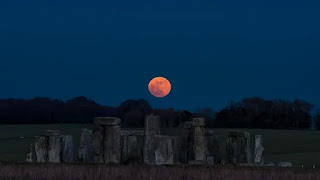Excerpted and edited from source below.
Archaeologists are investigating whether the design of Stonehenge has a connection to the moon. Stonehenge, the imposing megalithic monument that has dominated Salisbury plain in southwest England for some 4500 years, the solar alignment has long been obvious. The central axis of the stone circle is, and was, aligned with the sunrise at midsummer and sunset at midwinter. The stones dramatically frame the rising and setting sun when the days were at their longest and shortest.
The idea that Stonehenge might also be linked to the movements of the moon were promoted in the 1960s, but was not systematically explored. That is changing. New research indicates that Stonehenge, and potentially other megalithic monuments around the world, align with moon movements. This summer, archaeologists are using a little-known lunar phenomenon that happens every 18.6 years to investigate this possibility.
Like the sun, the moon also rises in the east and sets in the west. Moonrise and moonset, however, move from north to south and back again in the space of a month and not, as the solstices, in the span of a year. The northern and southern extremes also change over a period of about 18 and a half years. The lunar standstill, like the winter and summer solstices, is when the northernmost and southernmost moonrise and moonset are furtherest apart.
Track moonrise every day for a month and you will notice a northern and southern limit to where it rises on the horizon. Track this over a 19 year period and you will notice that there is defined a maximum limit (major lunar standstill) and a minimum limit (minor lunar standstill). This major lunar standstill is next due to happen in Janurary 2025, but from now until mid-2025 the moon will appear to be unusually low and high in the night sky during the lunar month.
How does this relate to Stonehenge? Stonehenge is made from two types of stone: larger sarsen stones (a type of sandstone), and smaller bluestones (a type of spotted dolerite, so called because it has white spots in the igneous blue rock). [Sandstone and blue rock with speckeled white?). What might the ancients have been contemplating?] These two types of rock form two concentric circles and there are four station stones that form a rectangle around the circle. These station stones roughly align with the moon’s extreme positions during the lunar standstill.
The solar alignments of Stonehenge have been long held to be intentional and such alignments have been identified in many places around the world and would have been relatively easy for ancient builders to identify, given that knowledge of the sun’s yearly cycle and its connection to the seasons would have been essential to livelihood. It is much more difficult to make such an association with the lunar standstill cycles.
Researchers have been documenting the moonrise and moonset at key moments when the moon is in alignment with the station stones. The moon is expected to align with the station stone rectangle twice a month from about February to November 2025.
But Stonehenge isn’t the only megalithic monument potentially linked to the witnessing of lunar standstills. Researchers are also investigating lunar alignments at Chimney Rock, a rocky ridge about 1000 feet above the valley floor in Colorado. The landmark features two large pillar-like rocks that frame the horizon. Between the years 900 and 1150 ancestors of the Pueblo people built multi-storied buildings and ritual spaces on this difficult-to-access high place. It remains an important site to the 26 Native American groups that have traditional or cultural ties to the area.
One researcher notes that the extraordinary view of the sky between the twin pinnacles suggests an astronomical connection, but the gap is slightly too far north for the Sun to ever shine through it. The Moon, however, can be seen to rise there when it is close to the most extreme northern position, during the major lunar standstill. The Calanais Standing Stones, situated on the Isle of Lewis in Scotland and erected before Stonehenge, may also have a link with the lunar standstill.
But skeptics propose that such alignments are more likely coincidental. Says one, “every ancient site has dozens-to-hundreds of potential sight lines, and one-or-more will always point somewhere near to one of the eight standstill directions.” They presume that the lunar standstill is hard for the casual observe to recognize and that it is really visible only in detailed data on observations of the Moonrise and Moonset.
This overlooks the fact that the ancients were watchers of the sky very closely and that they had nothing but time on their hands unlike we have assumed upon ourselves today. A moon watcher would have seen Moonrise and Moonset gradually drift farther towards their extreme northern and southern limits over time.
How they made use of this knowledge is a tantalizing question.








No comments:
Post a Comment
Be thoughtful, be helpful, be civil…